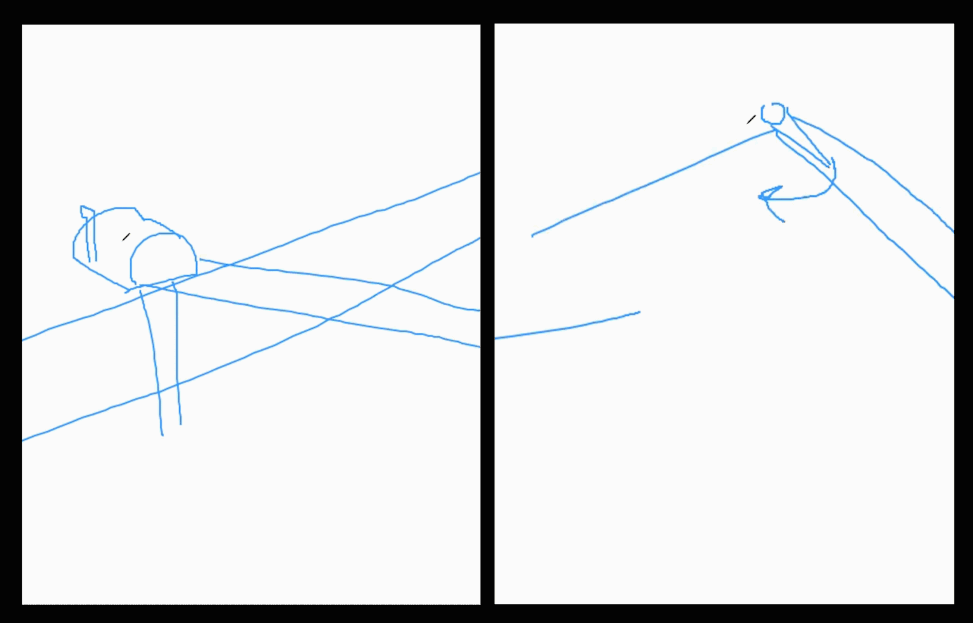Introduction
We are the Oaks! Our goal is to make an assistive device for a person living with a disability, with the hope that it improves their daily life and routine. With this in mind, we set to interview our client, Annie, to gauge her needs and find what she would most benefit from improving. This could be a task related or non-related to her disability, as long as it’s useful and fully customized to Annie’s needs. To understand her needs, we conducted an hour-long interview on April 8, 2021 with Annie as the interviewee and Amelia and Carlos as the interviewers. In the next section we will outline our interview agenda and summarize major takeaways from the interview.
Meeting Agenda
Before officially conducting the interview, it was essential to prepare a list of questions we planned on asking our client in order to maximize our time with her, make her feel comfortable sharing snippets of her life with us, and understanding the everyday problems she faces. Our interview agenda is split into four parts: introduction/ice breaker, explanation and clarification about project goals, understanding needs and thinking of possible technological interventions, and conclusion. Official agenda is linked here
- Introduction/Ice breaker consisted of (10 min):
- Carlos and I introducing ourselves with our name, major, year, and favorite thing about Pittsburgh and then asking her to do the same.
- Asking Annie what drew her to volunteer for the project
- Asking Annie for permission to record + take notes for the reminder of the interview
- Explanation and clarification about project goals consisted of (15 min):
- Explaining the purpose and limitations of the project (i.e. students in an intro class not aiming for perfection, aiming to make a gadget customized to you, not necessarily aimed for commercial use)
- Documenting the process along the way with lots of images, feedback, initial prototype, and finally a gadget
- Clarifying the timeline of the project and when she would step in to give feedback on the prototype we develop
- Showing her Gantt chart of project timeline
- Understanding needs and thinking of possible technological interventions (35 m)
- The bulk of the interview where we asked direction questions which will lead us to understand the scope of her problems, what solutions she’s tried in the past, and what an optimal solution would look like for her
- Questions we planned:
- Q: Tell us about your day, what are you most looking forward to when you start your day? What do you look forward to the least?
- Q: what everyday tasks do you need the most help with, and what can you do on your own?
- Q: What are some devices useful to you today and why can’t you live without them?
- Q: What are some devices that you would recommend to anyone with a condition. Alt. anyone with a similar condition as your own?
- Q: When would you say your condition started having an impact on your life? When was the tipping point to the lifestyle you have now?
- Conclusion (5 min)
- Thanking her for her time
- Giving our contact info and stating that we’ll send her emails with updates on how to project is going
- Addressing any last questions/concerns
Meeting Summary and Major Takeaways
Most of the solutions people come up with for Annie’s hassles end up frustrating her, and it ends up becoming a DIY job anyway. That’s where we come in, how Annie sees it. As young people, and as students, we have the creativity to think outside the box and to come up with solutions no one else can fathom.
The first issue Annie told us about was that she and her dog were able to open the door, but neither of them could close it. This is a problem because, while she lives in a very safe town that never even warrants locking the doors at night, leaving the door open, especially at night, could let in the rabbit skunks with rabies that are a problem in the summer. There must be a way to close the door.
Annie can’t access the mail from her 6ft-high porch to her mailbox. Her solution is asking a neighbor for help giving her her mail, but she doesn’t like spending those 10 minutes of her neighbors’ time every day.
If Annie turns on her fan and her overhead lights at the same time, the fan makes the lights flicker enough to give her seizures. Her solution is plugging in night lights into her sockets all over the room, which she then has to manually turn on and off every single one. The voice activated home assistant controls the lights in her entire house all at once, and it can’t target specific rooms of the house.
Sometimes Annie takes care of her brother’s dog. This dog loves taking all of the toothbrushes, but if she puts them somewhere the dog can’t reach it, she can’t either.
She does have a Google Home Mini, but the sound of her noisy power chair confuses the Home so that it can’t understand her voice.
As closely as I can quote her:
Tiny things make such a big difference. And they turn out not to be tiny at all.
This is what our ideations produced:

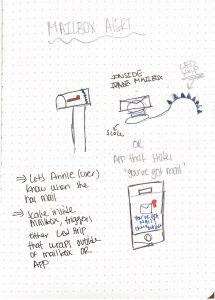
Notify Annie when she gets mail, so her neighbors don’t have to. Light up an LED strip or send a cellphone notification.
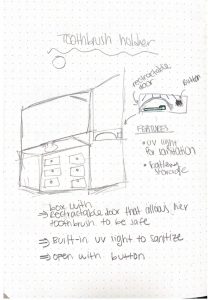
Store the toothbrush in a clear box that also serves as a nightlight. Keeps out of reach of brother’s dog.
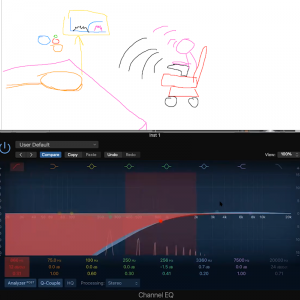
Filter the power chair’s loud sound out of the Google Home’s microphone so it doesn’t get in the way of her voice. Very out of scope.
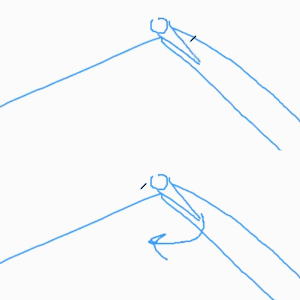
A servo or stepper motor shuts the door with the press of a button. Manual rotation in one direction (opening), motorized rotation in the other (closing). Also not within scope.
Reflection
We thought the meeting went great! After some trouble scheduling, we finally set up a time and met with each other. We had an easy time sticking to our agenda. Annie carried a lot of the conversation since she was really open about her hassles and about her life. This made it really easy to move the conversation forward and stimulate some ideas.
Unfortunately, Annie was getting driven home during our meeting, so she wasn’t able to turn on her video and show us her dog opening the door, or how high her bathroom vanity was, or any of what she was telling us about. We did ask her to send in some videos and photos of these things, and audio of her power chair, and we’re still waiting for those to come in.
